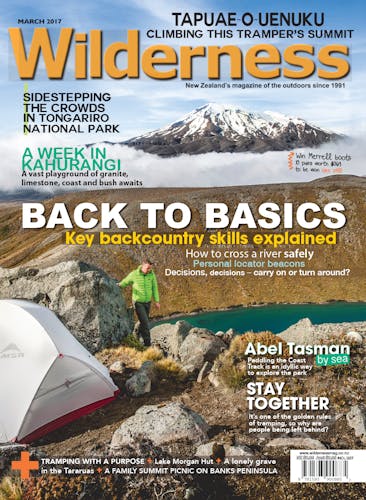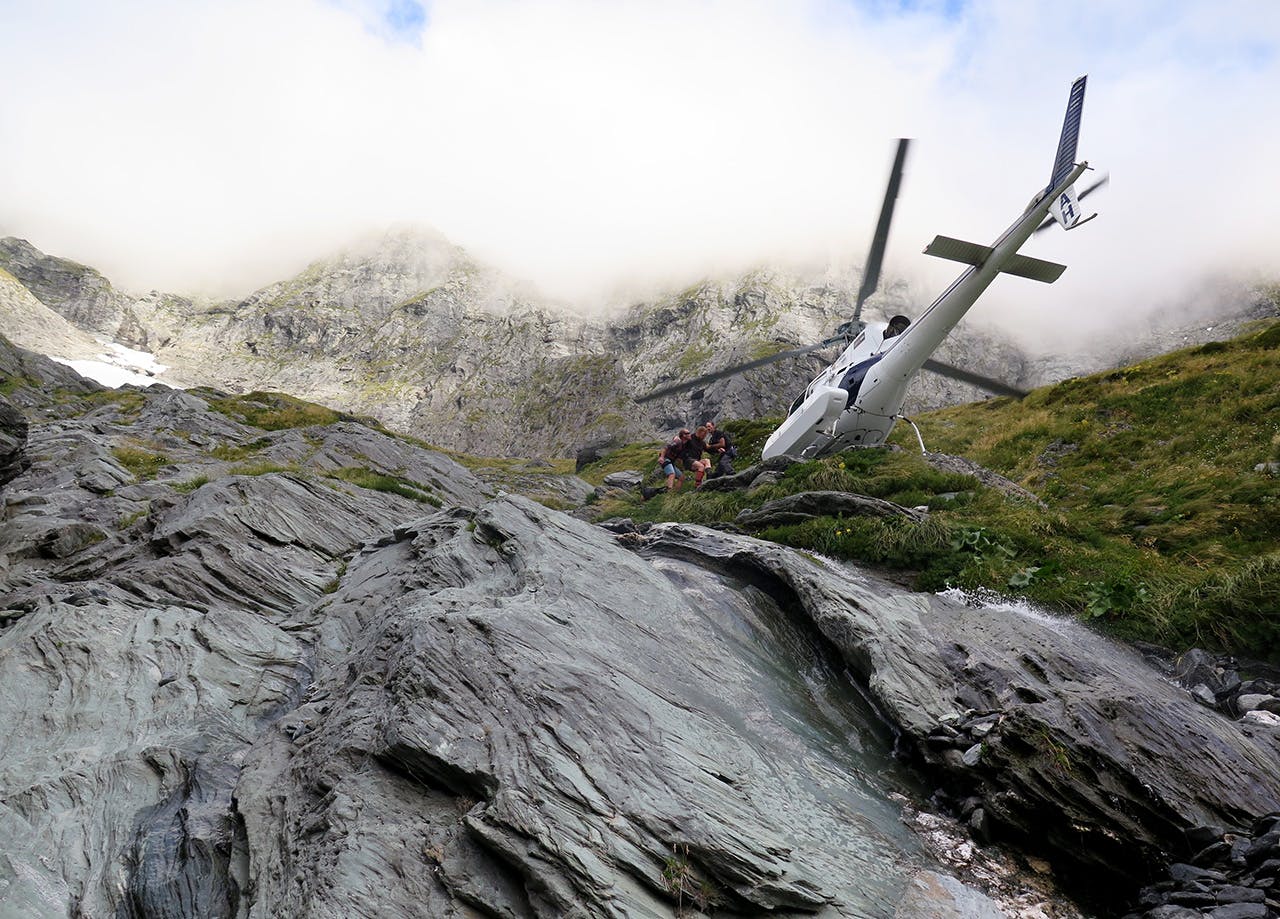From ad hoc hiking groups formed online to decades-old tramping buddies, a look at how leadership can make or break a tramping trip.
There’s a phenomenon in tramping that Noel Bigwood calls, “the Sunday afternoon scramble”.
“When trampers head out of the bush on a Sunday afternoon, they’ll have their last rest stop, and then head for the car,” Bigwood says. “When they get there, they’ll say, ‘Hey, where’s Charlie? Oh, he was just behind me! When? Three hours ago…’.”
In Bigwood’s 40 years as a search and rescue worker, he’s seen it happen several times.
“I’d call it lack of team discipline. It’s where they stop thinking about the team and start thinking about themselves, and stop caring about their mates,” Bigwood explains. “That’s why the Sunday afternoon scramble is the most common scenario – where everyone’s thinking ahead. Thinking about getting to the car, getting their boots off, having a nice drink when they get home, and they forget about the person who is struggling along behind them.”
There are numerous stories of situations over the years in which groups have left members behind. Some stories tell of intentional split-ups, whereas others happen more organically or accidentally.
In late 2015, there were at least two incidents in which trampers were left behind, necessitating rescues. In both situations, trampers were left on their own. One was a 54-year-old who fell ill on the Hollyford Track. His friends set off the PLB for his rescue, but then left him there and continued on.
In another situation, a woman was left behind by her friends while on a tramp in the Wairere Falls area near Matamata. Waikato Police Senior Sergeant Andrew O’Reilly said the group had left her halfway because she wasn’t able to keep up with them.
“As a tramper, you go to the speed of the slowest person. These people went on ahead, and they just decided to keep on going, I don’t know whether they knew the area at all. But the woman who was left behind did the right thing by staying in the same spot,” O’Reilly says. “I don’t even think they’d realised she’d dropped off the back of the group.”
The woman’s friends called police at 9:45pm, and she was found by search and rescue overnight.
O’Reilly says in his seven years as a search and rescue coordinator, he’s had very few call-outs for friends who left someone behind. “Surely you’d be looking after each other?”
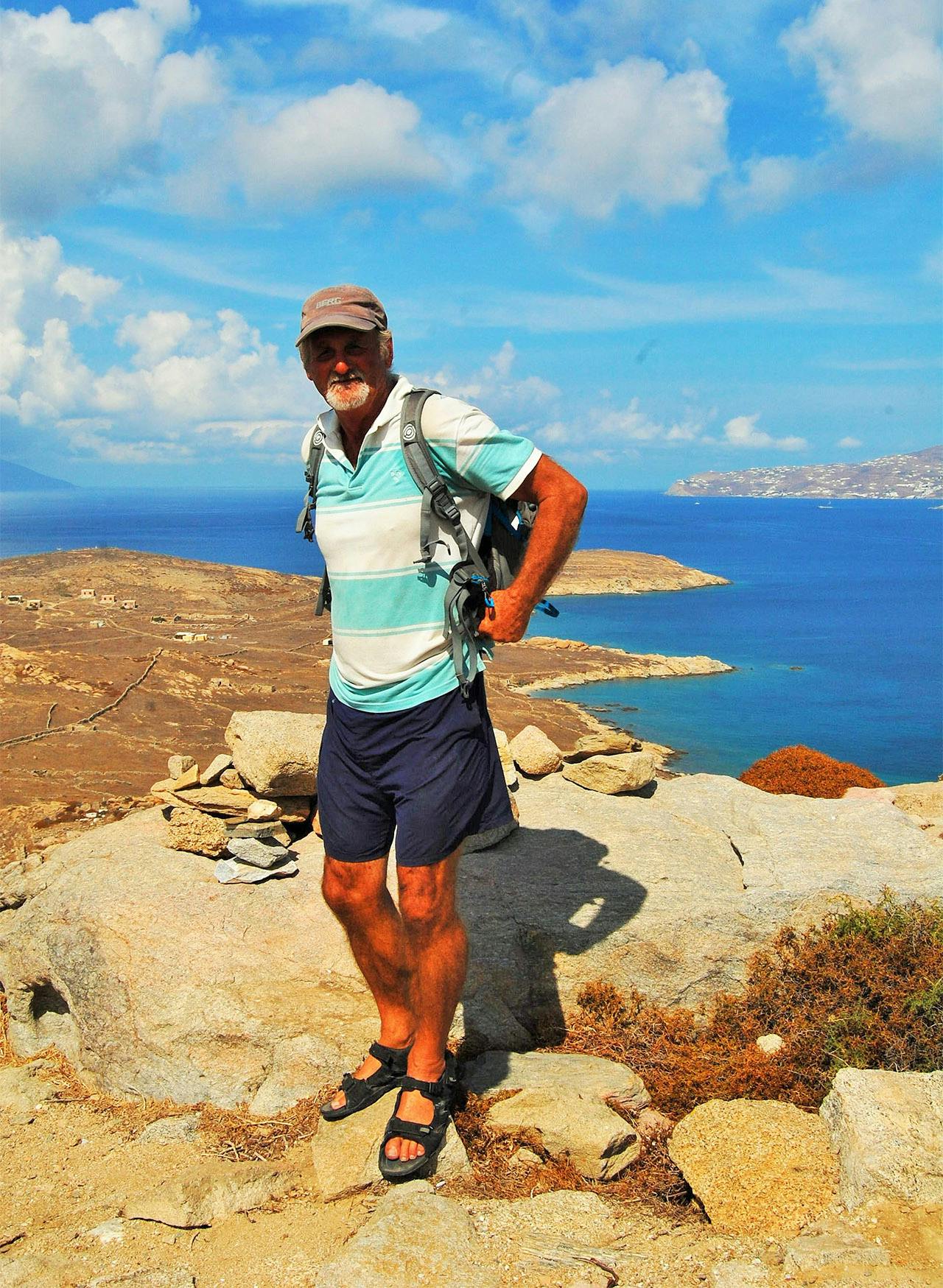
Trevor Beaton missed the walk briefing and ended up taking a wrong turn. Photo: Supplied
According to There and Back – An exploration of outdoor recreation incidents in New Zealand published by the Mountain Safety Council, “Over 70 per cent of all tramping search and rescues in New Zealand are for a solo tramper, or to rescue a single person lost or injured from a multi-person group.”
“You keep your team together unless there’s a damn good reason not to,” Bigwood says.
Most groups of friends don’t have a hard time following this mantra. When things can go a little haywire is in large groups, or groups that have only just met.
While tramping clubs are popular around the country, there’s also a strong following in the online, social media-organised recreation groups. The Meetup group called the Auckland Hiking Group has been around for about a decade, and has more than 12,000 members. Trips are organised almost every weekend, usually venturing into the Waitakere Ranges or other nearby parks, with up to 50 or so hikers on a busy day. For someone who is new to Auckland and wants to meet people and see the surrounding parks, it’s a great option. Most of the hikes are ideal for newbies and, for the most part, they’ve had no major problems with safety on their trips. That is, until the group planned a trip into the Hunua Ranges last year.
Trevor Beaton joined an Auckland Hiking Group day trip to Mangatangi Dam in September 2016. The plan was to do a one-way trip to Seabird Coast via the Workman and Whakatiwai tracks. After the initial meeting at Victoria Park in Auckland before departing the city, Beaton says the morning developed into “a comedy of errors”. Beaton and another tramper, Christine, had forgotten towels for the post-tramp swim at Miranda Hot Pools, so they made a quick stop at a shopping mall. The detour put them about 20 minutes behind the group, and by the time they reached the Mangatangi Dam car park, the group had already departed. “It was a fast-paced rush to keep up,” Beaton says, and it meant they missed the pre-tramp meeting. They caught up to the group about an hour later.
Because they weren’t at the meeting, Beaton says they missed information on track markings and rest breaks.
“To date I had only been on clearly defined tracks in the Waitakeres with the group, and was not aware of track markings,” he says, adding that he’d only been tramping for five months and had not yet been on trips that required track markings.
Three hours into the hike, they stopped for a rest break on a long, narrow grassy area, so the group was spread in a long line. After the break, he says the front group moved off at a “fairly brisk pace – the front runners could probably not see the tail end of the group.”
Beaton and a few others were at the back, and he stayed behind while Christine was re-packing her bag. “A lesson or rule that was drummed into my head by Outward Bound instructors many years ago; always support the back runners. Team effort is where it’s at,” Beaton says.
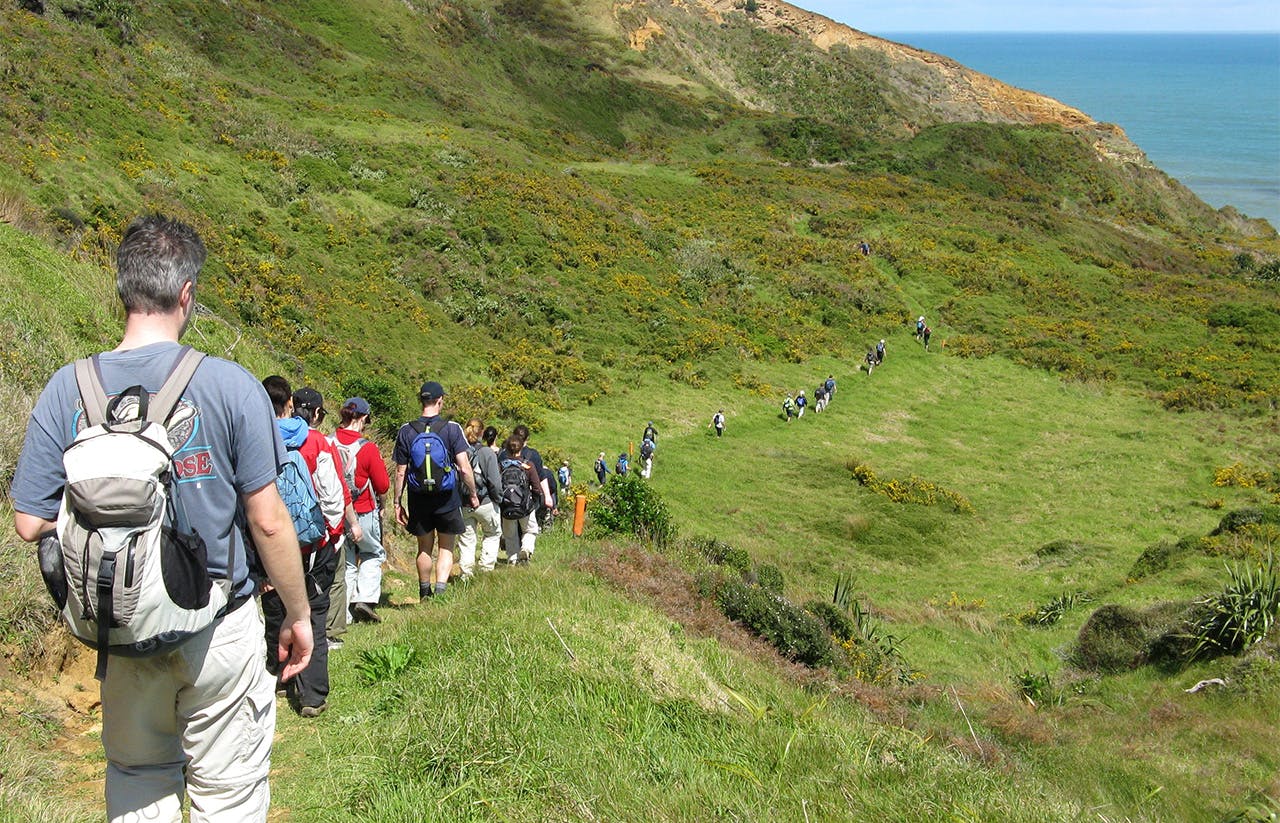
The larger the group, the harder it is to stay together. Photo: Josh Gale
Soon it was just the two of them, with Christine leading the way.
“At this stage the track was not clearly defined or worn into the ground…several times she lost direction back tracking to pick up the main track again,” Beaton says. They had been following orange triangle markers, but one obscured marker was missed, and they began following ribbons that he says looked “pink, almost orange.” They later learned those were possum-baiting markers.
It wasn’t long before they were completely off-track.
Auckland Hiking Group organiser Stephen Hawkins realised they were missing at the next rest stop, and the group backtracked trying to find them. They retraced their steps and called loudly into the bush for several hours.
“It’s quite hard to avoid on reflection,” Hawkins says. “There was only one track, but there were false trails, and they happened to follow one that none of us noticed.”
When it was clear they needed backup, Hawkins called search and rescue, and a full-fledged search was launched.
Beaton says they realised they had taken a wrong track a few hours later, as they’d seen no sign of the group. He looked at a Google map on his phone, and saw that they were quite far off-course, so they decided to retrace their steps to make it back to the main track. It was becoming dark, so they hunkered down in their survival blankets for the night. Beaton says they were lucky to have those, as they’d only planned for a day-hike and had little else in the way of gear.
Meanwhile, search and rescue had helicopters scanning the area, along with several volunteers on foot looking for them.
In the morning, Beaton and Christine regained their possum trail, and eventually found the main track again around midday. On their way back to the car park, they ran into a searcher, who called off the three search teams who were still out looking.
“Basically, if any part of the group – whether at the end, front or middle – lost sight of the person in front of them, then they could take a false trail like that without anyone knowing until the next stop,” Hawkins says. “By the time we went back to look, they were already so far off-track they couldn’t hear us. Unless everyone is tied together, I’m not sure how that could have been prevented.”
Peter Wilson, president of the Federated Mountain Clubs, knows how challenging it can be to manage a large tramping group. A veteran of the Otago University Tramping Club, he says his days at Uni taught him a lot about group dynamics on a tramp.
“You would sometimes have one leader to 25 people, and your group would end up getting spaced out over about five hours of track – we had all sorts of chaos and carnage,” Wilson says. While he sees the value in social media-organised groups such as Meetup, he also sees the potential pitfalls.
Wilson’s “hard-won” advice is pretty straightforward. For one, he says groups should stay small – not more than one leader to six people in a group.
He also says a leader should always be walking well below their capacity. “If the leader is at capacity, they have no time to think of the rest of the group. But if the leader is running below their capacity, they’re going to be in a better situation to keep an eye on what’s going on with the party, and that’s a really critical rule.”
But above all else, he stresses the importance of staying together.
“When you grow up learning to tramp in a tramping club, you learn some basic rules until they become so embedded in your outdoor soul that you don’t know anything else,” Wilson says. He calls it the “collective spirit”, or, no tramper left behind.
“If people are consuming tramping, and you’re buying a tramping product like you would with a Meetup group – you go along, you do a tramp, and you go away again – there’s not the collective cohesion with the group,” Wilson says, adding that the leader might not even be working with enough authority to hold the group together.
“That’s a challenge, because what it means is, in a danger situation, an injury, or a difference in the party, things aren’t going to hold together as well and people are going to want to go their separate ways. In those situations, when you’ve got a group of individuals who don’t know each other, it takes a pretty exceptional, good leader to be able to bring them together in a team to achieve something.”
Ad hoc tramping meet-ups aren’t the only groups prone to issues. Even with a group of old mates, things can go wrong.
Just over 10 years ago, Wilson had a close call, which he attributes to a phenomenon known as “risk shift”.
“Sometimes when a group of mates goes into the hills it’s really nice not to have a leader – that’s why you go tramping with mates, because you’re going as equals,” Wilson says.
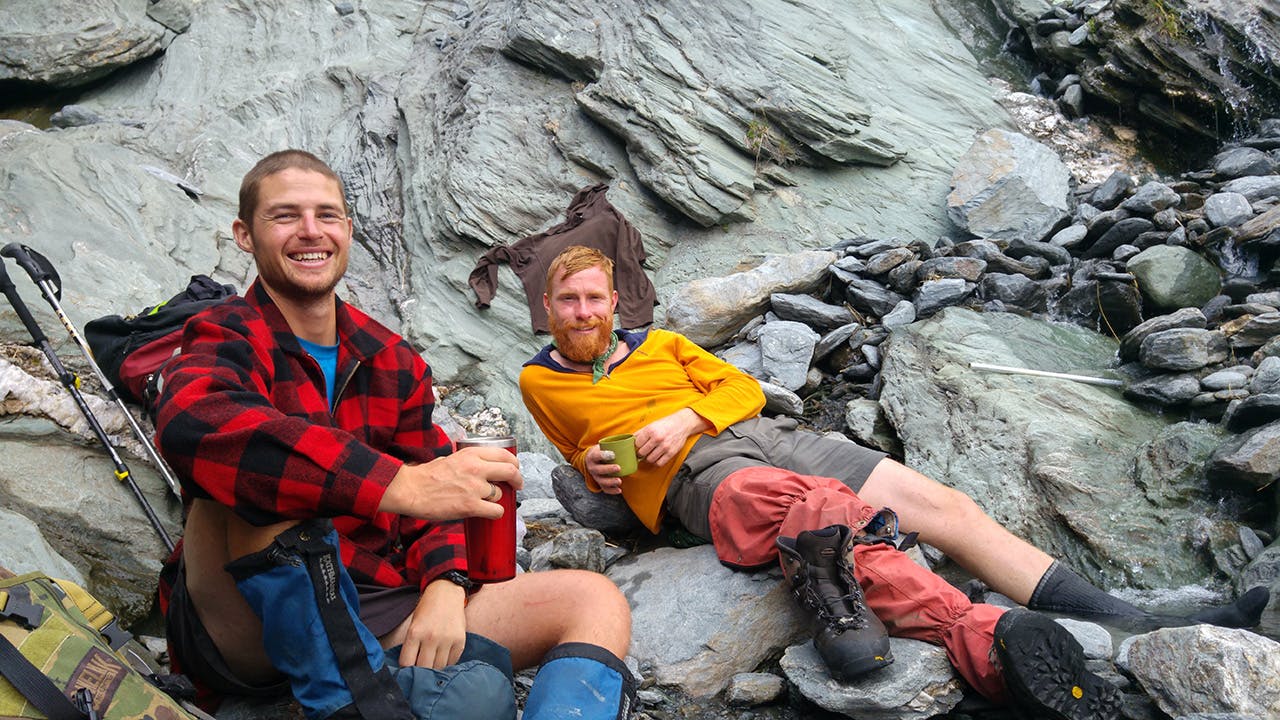
Waiting for help. Nick (left) was kept in good spirits until a helicopter arrived. Photo: Caroline Bellamy
Wilson was in the Olivine Wilderness Area in 2006 with friends, when poor weather moved in. They were walking along a snowy ridgeline in deteriorating weather when Wilson slipped and fell 100m. He landed at the base of a waterfall with torn knee ligaments and lacerations, but no broken bones. Wilson says his pack took the majority of the impact and likely saved his life.
“No one wanted to make the call that what we were doing was too dangerous,” Wilson says.
Regardless, he recognises that it’s not always easy or necessary to elect a leader when tramping with friends.
“Rather than designating a leader and assuming a leader will solve your problems – which is not always correct, and sometimes that can be disastrous – it’s just recognising that if you don’t have a leader, you’re prone to risk shift. It’s a fairly established phenomenon which is what happens when no one wants to make the call because no one wants to look bad, or look like a wuss, in front of their mates.
“Be aware that you don’t want to feed off each other, and at some point you have to make a group call that it might not be a good idea to go,” Wilson says.
Caroline Bellamy and her friends experienced first-hand what it’s like to address an emergency on a tramp. She and four tramping friends did an 18-day expedition in the Mt Aspiring National Park in early 2016. On day 12, one of the party, Nick, fell in a creek and broke his ankle.
They got out their PLB straight away and agreed to stay with the injured tramper.
They made tea, put his ankle in cold water, and waited for help.
“Four hours passed and the helicopter still hadn’t arrived, and it was going to get dark within the next couple of hours, so we had to consider what we were going to do if the helicopter didn’t come,” Bellamy says.
There was never a question of splitting up, she says; their main objective was to make Nick more comfortable and to get him to flat ground where they could put a fly up and hunker down for the night. But at the last minute, the helicopter arrived at sunset and was able to pick up their friend.
“If the helicopter hadn’t come by the morning, two or three of us would have walked to Colin Todd Hut, and the others would have stayed with Nick.” They would have then radioed from the hut to get help.
While they didn’t have a single leader on the trip, Bellamy says the decision-making was pretty straightforward.
“It was intuitive, and we’d all learned it in the past – it was taught to us. If we had to split up, we would have had someone stay with Nick – he wouldn’t have stayed by himself,” Bellamy says. “I think it’s good to get everyone’s opinion, but when it does come down to the really hard decisions, it’s good to have the most experienced person make the call.”





